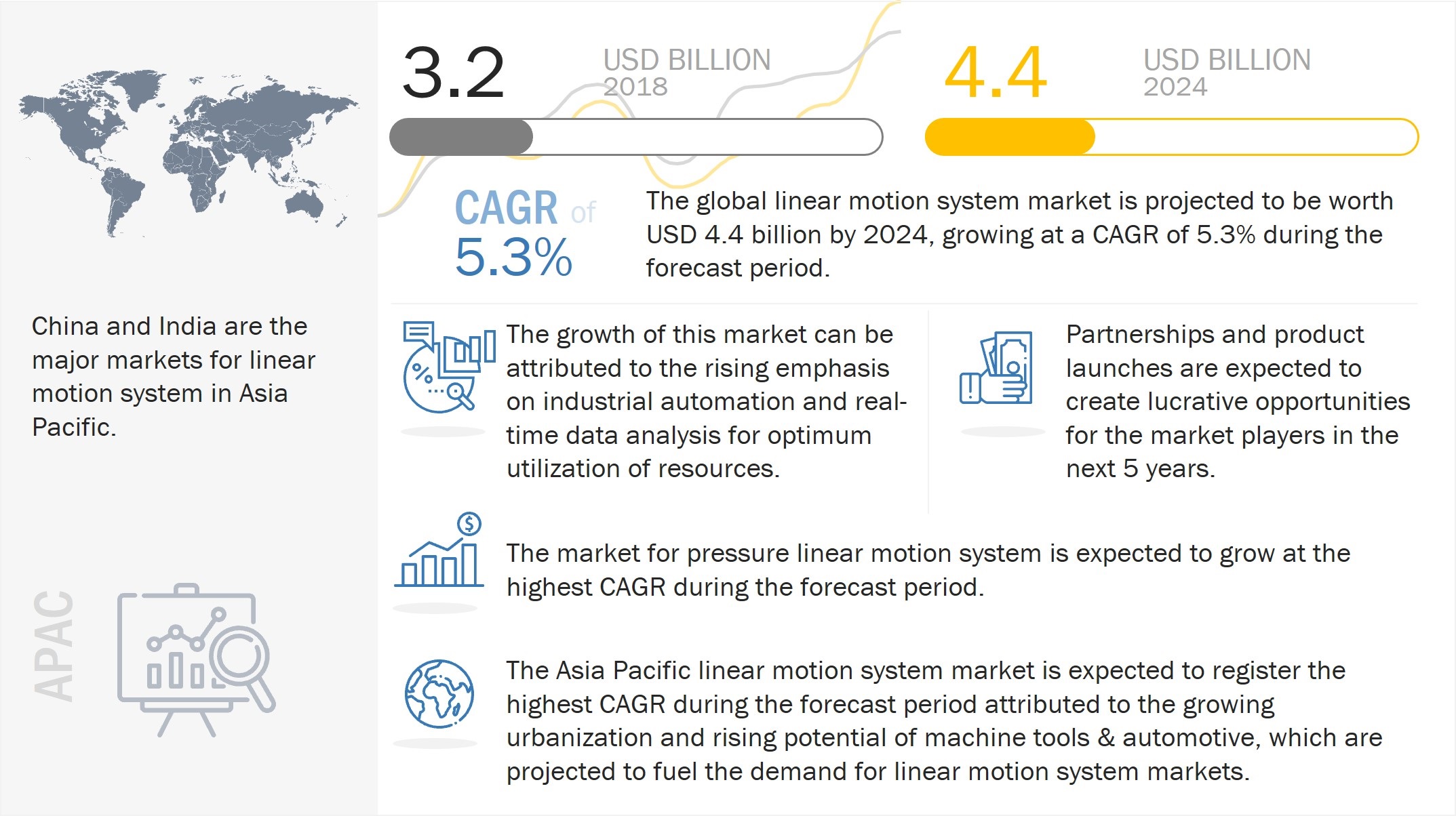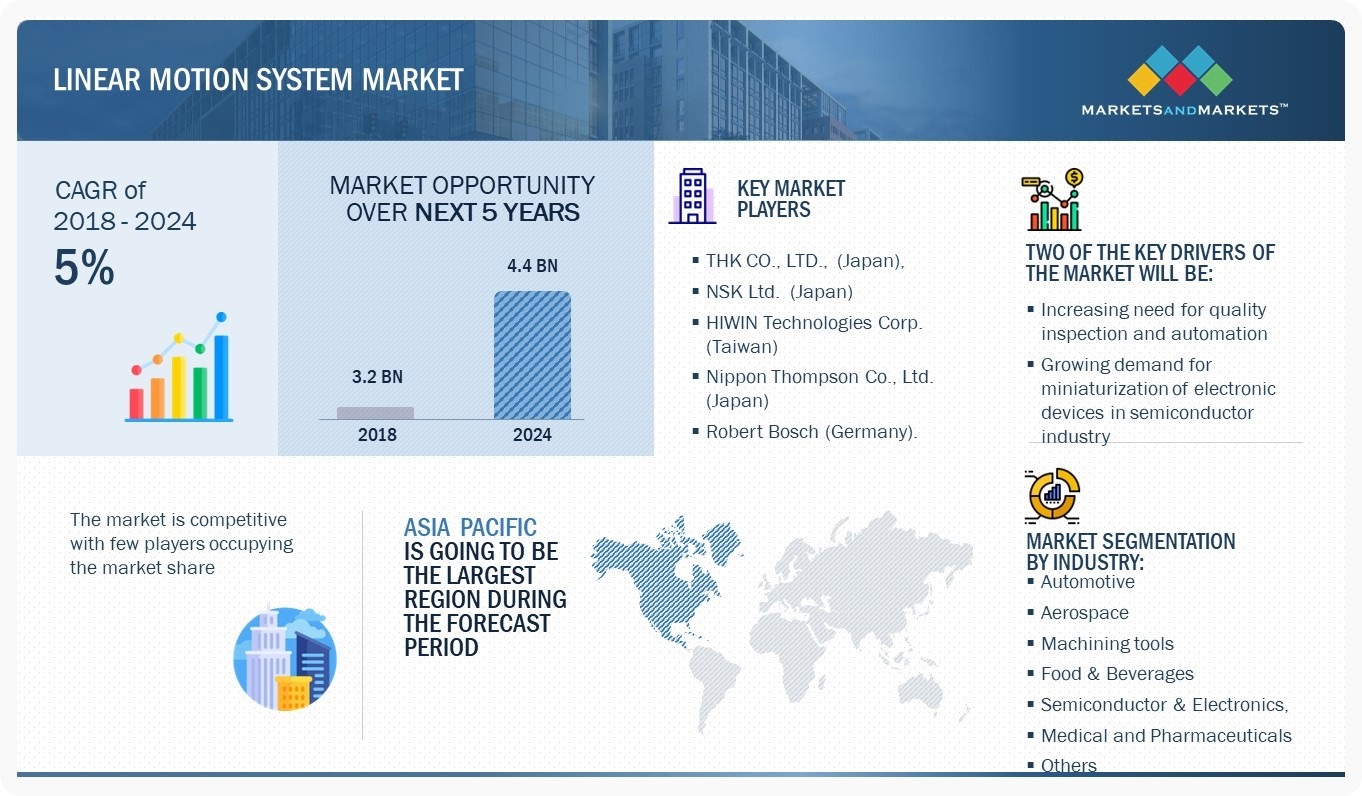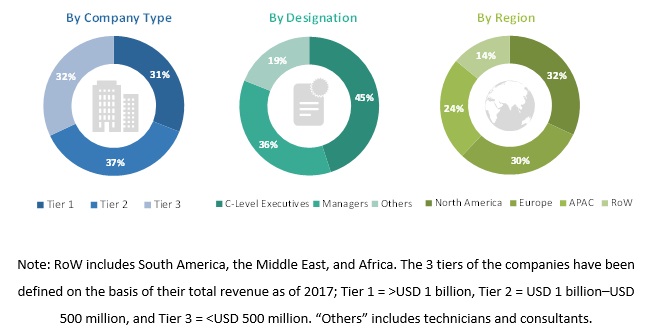Linear Motion Market by Component (Linear Guide, Actuators, Ball Screws, Linear Motors), Industry (Medical & Pharmaceuticals, Semiconductors & Electronics, Aerospace, Food & Beverages, Machining Tools, Automotive), Geography - Global Forecast to 2024
[95 Pages Report] The linear Motion System Market report share is estimated to be USD 3.2 billion in 2018 and expected to reach USD 4.4 Billion by 2024, at a CAGR of 5.3% from 2018 to 2024.
Linear motion is a one-dimension motion along a single direction in which an object moves along the same axis without fluctuating direction. Linear motion components offer high-performance capabilities such as high speed, high accuracy, and work in a harsh environment within a compact dimension.

Linear Motion System Market Forecast to 2024
To know about the assumptions considered for the study, Request for Free Sample Report
Linear motion component includes linear guides, tracks, actuators, motors, controllers, and precision ball screws that offers optimal travel performance, high load capacities, and high rigidity. These products serve various industrial applications such as packaging, testing & inspection, assembly, and palletizing.
Linear Motion System Market Dynamics:
Driver: Increasing need for quality inspection and automation
Product quality is a prime concern in manufacturing industries, especially pharmaceuticals, food & beverages, automotive, electronics, and semiconductors. In every manufacturing facility, the quality control branch plays an important role. Hence, manufacturers worldwide widely adopt automated linear motion products in their manufacturing and packaging lines. Nowadays, several manufacturers focus on efficient automated processes to reduce throughput time and increase productivity. Increasing demand for finer control over products manufactured or services delivered across industries; fuels the need for quality inspection and automation.
Restraint: High cost of installation for low-volume production
Despite the high demand for linear motion in manufacturing and packaging industries, there still exist restraints to adopting linear motion products for low-volume production, especially in businesses that produce low-volume products with a single production line. As linear motion products are designed per the requirements of an application of a user, it is an inevitable process of modifying or reconfiguring systems every time the application is changed. The cost of reconfiguring and reinstalling these products is high for low volume production.
Opportunity : Growing investments in industrial automation and robotics
Linear motion products are designed to meet the requirements of engineers involved in designing applications in industrial automation and robotics. These products reduce the size of robots while increasing their rigidity and operational speed. The robotic sector gives companies access to the rapidly growing linear motion in manufacturing industries through partnerships, mergers, production expansion, and acquisitions. For instance, in January 2022, FANUC America, a leading supplier of CNCs, robotics, and ROBOMACHINEs, announced a West Campus expansion that will push its operational space in Oakland County, Michigan, to nearly two million square feet.
Challenge: Lack of skilled manpower to handle complex processes in the automation field
Increasing dependence on automated linear motion equipment might challenge the industry demand, as any small error in the machine might cause a total system failure. These failures can be reduced by hiring skilled workers. This would increase the demand for skilled technicians. However, in most industries, managers face a shortage of qualified engineers and maintenance staff to support and maintain equipment properly. The use of many linear motion components necessitates the requirement of highly skilled workers to mount components and harness cables. Managers must also find a way to transfer the experience from an older and more experienced generation of engineers to the new generation.
Linear Motion System Market Segment Insights:

Based on components, the Linear guides, tracks, and actuators segment held the largest market share in 2018.
Linear guides, tracks, and actuators account for most of the linear motion market share. Linear guides are designed to provide linear movement in industrial applications. According to the customer application, these guides are integrated with rails, carriages, and movers. Miniature linear guides are the tiny version of the larger monorail and guide systems developed and designed for small space applications. Ball screws, motors and drives, and others fulfill the most demanding applications in terms of efficiency, precision, durability, and value. The growing need for automation in various industrial applications, such as packaging and assembly of products, drives the linear motion market.
Based on Industry, the Machining Tools segment dominated the linear motion system market in the year 2018
Machine tools and material handling systems are used to carry out different operations on metals, such as cutting, boring, grinding, shearing, and other forms of deformation. Due to these processes' hazardous nature, industrial robots and linear motion tracks are the preferred choices. Moreover, linear motion components are used to automate these processes to offer high reliability and low maintenance solutions for these applications. These components focus on the optimum performance of the equipment used to perform repetitive tasks. Hence, this industry is expected to hold the largest share of the overall Linear Motion System Market during the forecast period.
Regional Insights:
The Asia Pacific region is projected to Grow at the highest CAGR during the forecast period
Increasing industrial activity and the demand for faster and more accurate linear motion products to achieve high production output and return on investment in APAC. Increasing demand for energy-efficient production processes coupled with the need for automated systems fosters the growth of the linear motion market. High growth observed in machining tool production and other sectors related to the production of electronic products and automobiles, which includes electronics assembly, semiconductor machinery, and customized robots for different applications, are some of the reasons for the growth of the linear motion market in APAC.

Linear Motion System Market by Region
To know about the assumptions considered for the study, download the pdf brochure
Key Market Players in Liner Motion Market :
Some of the Major players in the Linear Motion System Market are THK CO., LTD. (Japan), NSK Ltd. (Japan), HIWIN Technologies Corp. (Taiwan), Nippon Thompson Co., Ltd. (Japan), and Robert Bosch (Germany). These players have adopted various growth strategies such as contracts, joint ventures, partnerships & agreements, acquisitions, and new product launches to expand their presence in the Linear Motion System Market.
THK CO., LTD. manufactures and supplies vital machine components worldwide. THK products help customers convert slippage into controlled rotary motion, enabling machinery parts to move smoothly, efficiently, and precisely with linear motion. The company has focused on creation and development and has developed various products, including linear motion (LM) guides, since the company’s establishment. THK has established an integrated production and sales structure of 118 sales offices and 35 production facilities. The company’s products are used for machine tools, general industrial machinery, precision instruments, semiconductor, and LCD manufacturing equipment, industrial robots, electronic devices, and transport systems, as well as in construction, aerospace, medical and assistive, and other manufacturing industries.
NSK Ltd. produced the first ball bearings in Japan. Since then, the company has spearheaded the development of bearings in Japan. NSK currently offers a full range of bearings and sells them globally. NSK bearings have significantly contributed to many industries' growth and mechanical technology advancement. Presently, the company has the largest share of the bearings market in Japan and is one of the largest bearing suppliers in the world. The company has used its expertise in precision machining technology that has been refined through years of bearing manufacturing. This has been done to diversify into automotive products, precision machinery & parts, and mechatronics products. The company operates in 3 major business units: Automotive, Industrial Machinery, and Others. The Industrial Machinery business includes producing and selling industrial machinery bearings, precision machines & parts, among others.
Linear Motion System Market Report Scope :
|
Report Metric |
Details |
| Estimated Market Size | USD 3.2 Billion |
| Projected Market Size | USD 4.4 Billion |
| Growth Rate | 5.3% CAGR |
|
Historical Data Available for Years |
2015–2024 |
|
Base Year Considered |
2017 |
|
Forecast period |
2018–2024 |
|
Forecast units |
Value (USD) |
|
Segments covered |
|
|
Region Covered |
|
|
Market Leaders |
|
| Key Market Driver | Increasing need for quality inspection and automation |
| Key Market Opportunity | Growing investments in industrial automation and robotics |
| Largest Growing Region | Asia Pacific |
| Largest Market Share Segment | Linear guides, tracks, and actuators |
| Highest CAGR Segment | Automotive Industry |
This research report categorizes the linear motion market based on type, industry, and region.
Linear Motion Market, by Industry:
- Aerospace
- Automotive
- Medical and Pharmaceutical
- Machining Tools
- Semiconductor & Electronics
- Food & Beverages
- Others (Paper and Pulp and Textile)
Linear Motion Market, by Region:
- North America
- Europe
- Asia Pacific
- Rest of the World
Linear Motion System Market Highlights:

What is new?
- Major developments that can change the business landscape as well as market forecasts.
The Linear motion system industry has witnessed numerous technological advancements in system and payload capabilities. Substantial investments have been made in the linear motion system's research & development and upgrades. The value chain of the linear motion ecosystem starts with research and development (R&D), which comprises system requirements analysis, comparison of electronics specifications, and prototype development, followed by manufacturing and system integration phases.
-
Emerging Technology Trends
- Internet of Things (IoT)
- Robotics
- Artificial intelligence (AI)
- Addition/refinement in segmentation–Increase the depth or width of market segmentation.
Linear Motion System Market, by Components
- Linear guides, Tables, and Actuators
- Ball Screws
- Linear motors & Drives
- Others
-
Linear Motion System Market, by Industry
- Automotive
- Aerospace
- Machining Tools
- Food & Beverages
- Semiconductor & Electronics
- Medical and Pharmaceuticals
- Others.
- Inclusion of new players and change in the market share of existing players - Linear Motion System Market
Company profiles: Company profiles give a glimpse of the key players in the market with respect to their business overviews, financials, product offerings, recent developments undertaken by them, and MnM view. In the new edition of the report, we have a total of 25 players (15 major, 10 Startups/SME). Moreover, the share of companies operating in the Linear Motion System Market and start-up matrix have also been provided in the report.
- Updated financial information and product portfolios of players operating in the Linear Motion System Market
Newer and improved representation of financial information: The latest edition of the report provides updated financial information in the Linear Motion System Market till 2021/2022 for each listed company in the graphical representation in a single diagram (instead of multiple tables). This would help to easily analyze the present status of profiled companies in terms of their financial strength, profitability, key revenue-generating region/country, business segment focus in terms of the highest revenue-generating segment, and investment in research and development activities.
- Recent market developments of the profiled players
Recent Developments: Updated market developments such as contracts, joint ventures, partnerships & agreements, acquisitions, new product launches, investments, funding, and certification have been mapped for 2020 to 2022.
- New data points/analysis which was not present in the previous version of the report
- Competitive benchmarking of startups/SMEs covers employee details, financial status, the latest funding round, and total funding (if available).
- Inclusion of the impact of megatrends on the Linear Motion System Market that includes a shift in global climate change, rapid urbanization, greater customization, and disruptive technologies
- Technology analysis and case studies are added in this edition of the report to give the technological perspective and the significance of the advancements in the Linear Motion System Market
- We have included brief patent information for the overall market of Linear Motion Systems.
- The startup evaluation matrix is added in this edition of the report, covering startups.
The new edition of the report consists of trends/disruptions in customer business, tariff & regulatory landscape, pricing analysis, and a market ecosystem map to better understand Linear Motion System's market dynamics.
Recent Developments in Linear Motion Industry
- In March 2022, Ewellix, the leading global innovator and manufacturer of advanced linear motion technologies, launched an intelligent digital platform to underpin a new and advanced generation of linear motion solutions. SmartX, the new digital platform, has been designed to help engineers develop motion, robotic, and automation systems that offer far greater intelligence, connectivity, and adaptability than achievable from existing equipment.
- In October 2022, NSK Ltd. launched ball screws for Next-Generation high-accuracy machine tools that provide higher surface finish quality for high-accuracy machine tools used in die and mould machining and other applications.
Frequently Asked Questions (FAQs):
What is the current size of the Linear Motion System Market?
The Linear Motion System Market is projected to grow to USD 3.2 billion in 2018 to USD 4.4 Billion by 2024, at a CAGR of 3.2% between 2018-2024.
Who are the winners in the Linear Motion System Market?
THK CO., LTD. (Japan), NSK Ltd. (Japan), HIWIN Technologies Corp. (Taiwan), Nippon Thompson Co., Ltd. (Japan), Robert Bosch (Germany).
What are some of the technological advancements in the market?
Improved Programmable Logic Controllers (PLC) are used for motion control in electric linear actuators. These controllers provide accurate control over acceleration, speed, and torque. However, today, with improvement in the processing power of these PLCs, they can handle motion control tasks much more efficiently. PLCs now enable better connectivity than their earlier counterparts.
Compact Sized Motor Drives: With the world driven towards miniaturization, there is increasing demand for compact sized linear motion actuators and other motion control devices. Thus, there is an increasing demand for compact-sized motor drives.
What are the factors driving the growth of the market?
Increasing need for quality inspection and automation, reduced time-to-market, and growing demand for the miniaturization of electronic devices in the semiconductor industry
To speak to our analyst for a discussion on the above findings, click Speak to Analyst

Table of Contents
1 Introduction (Page No. - 11)
1.1 Study Objectives
1.2 Definition
1.3 Study Scope
1.3.1 Markets Covered
1.3.2 Years Considered
1.4 Currency
1.5 Limitations
1.6 Stakeholders
2 Research Methodology (Page No. - 14)
2.1 Research Data
2.1.1 Secondary Data
2.1.1.1 Secondary Sources
2.1.2 Primary Data
2.1.2.1 Primary Sources
2.1.3 Secondary and Primary Research
2.1.3.1 Key Industry Insights
2.1.3.2 Breakdown of Primaries
2.2 Market Size Estimation
2.2.1 Bottom-Up Approach
2.2.1.1 Approach for Arriving at Market Size By Bottom-Up Analysis
2.2.2 Top-Down Approach
2.2.2.1 Approach for Capturing Market Size By Top-Down Analysis
2.3 Market Breakdown and Data Triangulation
2.4 Research Assumption
3 Executive Summary (Page No. - 24)
4 Premium Insights (Page No. - 26)
4.1 Attractive Opportunities in Linear Motion Market
4.2 Market, By Industry, 2018–2024
4.3 Market, By Industry and Region, 2018–2024
4.4 Market, By Region, 2018–2024
5 Market Overview (Page No. - 29)
5.1 Introduction
5.2 Market Dynamics
5.2.1 Drivers
5.2.1.1 Increasing Need for Quality Inspection and Automation
5.2.1.2 Reduce Time-To-Market
5.2.1.3 Growing Demand for Miniaturization of Electronic Devices in Semiconductor Industry
5.2.2 Restraints
5.2.2.1 High Cost of Installation for Low-Volume Production
5.2.3 Opportunities
5.2.3.1 Rising Mergers & Acquisitions Regarding Linear Motion Technology Products
5.2.3.2 Growing Investments in Industrial Automation and Robotics
5.2.3.3 Government Initiatives to Support Industrial Automation
5.2.4 Challenges
5.2.4.1 Lack of Skilled Manpower to Handle Complex Processes in Automation Field
5.3 Value Chain Analysis: Linear Motion Market
6 Linear Motion, By Components (Page No. - 35)
6.1 Introduction
6.2 Linear Guides, Tables, and Actuators
6.3 Ball Screws
6.4 Linear Motors and Drives
6.5 Others
7 Linear Motion Market, By Industry (Page No. - 37)
7.1 Introduction
7.2 Medical and Pharmaceuticals
7.2.1 Linear Motion Market has High Growth Opportunity in Medical Industry for Medicine and Medical Equipment Manufacturing
7.3 Semiconductor & Electronics
7.3.1 Linear Motion are Used for Constantly Changing Application Requirements in Semiconductor & Electronics Industry
7.4 Aerospace
7.4.1 Aerospace Industry Use Linear Motion to Deliver High-Quality High-Performance Products With Zero Failure Rate
7.5 Food & Beverages
7.5.1 Food & Beverage Companies Compete With Each Other to Deliver Advanced Processing, Pertaining to the High Demand for Linear Motion Products
7.6 Machining Tools
7.6.1 Machining Tools Utilizes Linear Motion to Achieve Repetitive Tasks for Automation
7.7 Automotive
7.7.1 Rapid Developments in the Automotive Industry Owing to the Fastest Growth of Linear Motion
7.8 Others
7.8.1 Others Including Paper and Pulp and Textile Industries Pose Moderate Demand for Linear Motion Components
8 Geographic Analysis (Page No. - 46)
8.1 Introduction
8.2 North America
8.2.1 North America has High Demand Regarding Factory Automation and Technological Advancements in Robotics
8.3 Europe
8.3.1 Increasing Awareness Regarding Precise Methods of Linear Motion for Industries, and Development of Advanced Linear Motion Drives the Market Growth
8.4 Asia Pacific
8.4.1 Increasing Production of Machine Tools, Smart Phones, and Automobiles Drives the Market
8.5 Rest of the World
8.5.1 Machining Tools Industry Accounted for the Highest Share of the Market in 2018
9 Competitive Landscape (Page No. - 56)
9.1 Overview
9.2 Market Share Analysis of Linear Motion Market Players
9.3 Competitive Situations and Trends
9.3.1 Product Launches
9.3.2 Acquisitions, Collaborations, Expansions and Contracts
10 Company Profiles (Page No. - 60)
10.1 Introduction
(Business Overview, Products Offered, Recent Developments, MnM View, SWOT Analysis)*
10.2 Key Players
10.2.1 THK
10.2.2 NSK
10.2.3 Hiwin Technologies
10.2.4 Nippon Thompson (IKO)
10.2.5 Robert Bosch
10.2.6 Schaeffler Technologies
10.2.7 Rockwell Automation
10.2.8 Timken Company
10.2.9 Fortive
10.2.10 Hepcomotion
10.2.11 Schneeberger
10.3 Other Prominent Players
10.3.1 SKF Motion Technologies
10.3.2 Pacific Bearing Corporation (PBC)
10.3.3 Beckhoff
*Business Overview, Products Offered, Recent Developments, MnM View, SWOT Analysis Might Not Be Captured in Case of Unlisted Companies.
11 Appendix (Page No. - 89)
11.1 Discussion Guide
11.2 Knowledge Store: Marketsandmarkets’ Subscription Portal
11.3 Available Customizations
11.4 Related Reports
11.5 Author Details
List of Tables (15 Tables)
Table 1 Linear Motion Market, 2015–2024 (USD Million)
Table 2 Market, By Industry, 2015–2024 (USD Million)
Table 3 Market for Medical and Pharmaceuticals Industry, By Region, 2015–2024 (USD Million)
Table 4 Market for Semiconductor & Electronics Industry, By Region, 2015–2024 (USD Million)
Table 5 Market for Aerospace Industry, By Region, 2015–2024 (USD Million)
Table 6 Market for Food & Beverages Industry, By Region, 2015–2024 (USD Million)
Table 7 Market for Machining Tools Industry, By Region, 2015–2024 (USD Million)
Table 8 Market for Automotive Industry, By Region, 2015–2024 (USD Million)
Table 9 Market for Other Industry, By Region, 2015–2024 (USD Million)
Table 10 Market, By Region, 2015–2024 (USD Million)
Table 11 Market in North America, By Industry, 2015–2024 (USD Million)
Table 12 Market in Europe By Industry, 2015–2024 (USD Million)
Table 13 Market in APAC By Industry, 2015–2024 (USD Million)
Table 14 Market in RoW, By Industry, 2015–2024 (USD Million)
Table 15 Market Share of Key Players in Market, 2017
List of Figures (32 Figures)
Figure 1 Linear Motion Market Segmentation
Figure 2 Market: Research Design
Figure 3 Market Size Estimation Methodology: Bottom-Up Approach
Figure 4 Market Size Estimation Methodology: Top-Down Approach
Figure 5 Data Triangulation
Figure 6 Automobile Industry to Witness Highest CAGR in Market During Forecast Period
Figure 7 APAC Expected to Hold Largest Market Share of Market in Between 2018 and 2024
Figure 8 Growing Need for Quality Inspection and Automation Drives Growth of Market
Figure 9 Machining Tools Industry Expected to Hold Largest Share of Market By 2024
Figure 10 Machining Tools Industry and APAC Expected to Hold Largest Share of Market in 2018
Figure 11 Market in APAC Expected to Grow at Highest CAGR During 2018–2024
Figure 12 DROC: Linear Motion Market
Figure 13 Value Chain Analysis: Maximum Value Added During the Manufacturing and System Integration Stages
Figure 14 Linear Motion, By Components
Figure 15 Market, By Industry
Figure 16 Market to Dominate By Machining Tools Industry During Forecast Period
Figure 17 Market for Machine Tools to Dominate By APAC Region During Forecast Period
Figure 18 Market, By Region
Figure 19 Market to Dominate in APAC During Forecast Period
Figure 20 North America Market Snapshot
Figure 21 Europe Market Snapshot
Figure 22 APAC Market Snapshot
Figure 23 Acquisitions as Key Growth Strategies Adopted By Companies During 2015–2018
Figure 24 THK: Company Snapshot
Figure 25 NSK: Company Snapshot
Figure 26 Hiwin Technologies: Company Snapshot
Figure 27 Nippon Thompson (IKO): Company Snapshot
Figure 28 Robert Bosch: Company Snapshot
Figure 29 Schaeffler Technologies: Company Snapshot
Figure 30 Rockwell Automation: Company Snapshot
Figure 31 Timken: Company Snapshot
Figure 32 Fortive: Company Snapshot
The study has involved 4 major activities to estimate the linear motion market at present. Exhaustive secondary research has been conducted to collect information on the market, peer market, and parent market. Validation of these findings, assumptions with industry experts across the value chain through primary research has been the next step. Both top-down and bottom-up approaches have been employed to estimate the complete market size. After that, market breakdown and data triangulation procedures have been used to estimate the market size of each segment and subsegment.
Secondary Research
In the secondary research process, secondary sources such as Hoovers, Bloomberg BusinessWeek, and Dun & Bradstreet have been referred to for identifying and collecting information for this study. Secondary sources included annual reports, press releases, research magazines, and investor presentations of companies, white papers, certified publications, articles by recognized authors, gold standard and silver standard websites, associations, regulatory bodies, trade directories, and databases.
Primary Research
The linear motion market comprises several stakeholders, such as component manufacturers, solution and service providers, associations, and regulatory organizations in the supply chain. The demand side of this market is characterized by government organizations, end users, universities, and others. The supply side is characterized by components manufacturers, OEMs, integrators, end-to-end solution providers, system integrators and concessionaires. Various primary sources from both the supply and demand sides of the market have been interviewed to obtain qualitative and quantitative information. The breakdown of primary respondents is as follows.

To know about the assumptions considered for the study, download the pdf brochure
Market Size Estimation
Both top-down and bottom-up approaches have been used to estimate and validate the total size of the linear motion market. These methods have also been used extensively to estimate the size of various subsegments in the market. Following is the method to estimate the market size:
- Major players in the industry and markets have been identified through extensive secondary research.
- The industry’s supply chain and market size, in terms of value, have been determined through primary and secondary research processes.
- All percentage shares, splits, and breakdowns have been determined using secondary sources and verified through primary sources.
Data Triangulation
After arriving at the overall market size using the estimation processes as explained above the market has been split into several segments and subsegments. To complete the overall market engineering process and arrive at the exact statistics of each market segment and subsegment, the data triangulation and market breakdown procedures have been employed, wherever applicable. The data have been triangulated by studying various factors and trends from both the demand and supply sides.
Report Objectives
- To describe and forecast the global linear motion market, in terms of value, segmented on the basis of industry, and geography
- To forecast the market for various segments, in terms of value, with regard to 4 main regions: North America, Europe, Asia Pacific (APAC), and Rest of the World (RoW)
- To provide detailed information regarding drivers, restraints, opportunities, and challenges pertaining to the linear motion market
- To strategically analyze the micromarkets1 with regard to individual growth trends, prospects, and contribution to the global market
- To provide the linear motion value chain analysis
- To strategically profile key players in the market and comprehensively analyze their market positions in terms of ranking and core competencies,2 along with detailing the competitive landscape for market leaders
- To analyze competitive developments such as product launches, acquisitions, collaborations, partnerships, and expansions in the linear motion market
Available Customizations:
With the given market data, MarketsandMarkets offers customizations according to the company’s specific needs.
The following customization options are available for the report:
Product Analysis
- Product matrix that gives a detailed comparison of the product portfolio of each company
Company Information
- Detailed analysis and profiling of additional market players (up to 5)















Growth opportunities and latent adjacency in Linear Motion Market